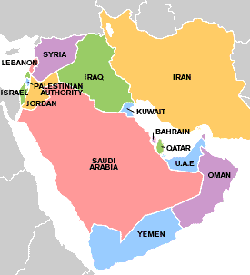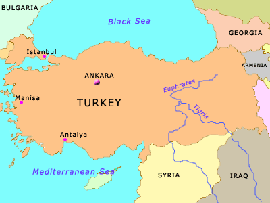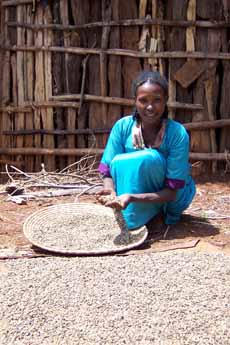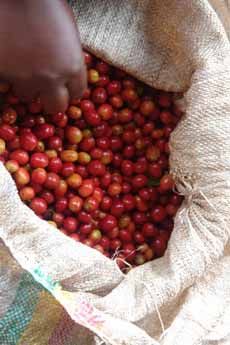This is Page 2 of a three-page article. Click on the black links to visit other pages.
Modern Coffee Is Invented
Coffee cultivation was rare until the 15th and 16th centuries, when extensive planting of the trees occurred in the Yemen region of Arabia.
From Yemen the use and trading of coffee beans spread throughout the Arabian peninsula (what is now called the Middle East) and later via the Ottoman Empire to Turkey, which lay immediately north of it, across the border of modern-day Syria and Iraq.
At that time, coffee was used for its medicinal properties and as a ritual drink. However, the drink was not as we know it today: The green (unroasted) coffee beans were boiled. The world’s first coffee shop, Kiva Han, opened in Constantinople in 1475.
 |
 |
| At left, the Arabian Peninsula. Yemen, at the southern tip, was the “birthplace” of the coffee beverage, but the Yemenites boiled the green coffee beans. When coffee migrated north, the Turks roasted the beans. |
The modern coffee drink was invented at the end of 15th century, when roasting and crushing the coffee beans over open fires before extracting them with hot water became the accepted methodology.
The Turks claimed coffee to be an aphrodisiac and husbands kept their wives well supplied. If the husband did not supply coffee, it was a legitimate cause for a wife to divorce.
Coffeehouses became the social centers, competing with mosques for attendance. As gathering places for political activity and sedition, they banned several times over the next few decades, but they kept reappearing. Eventually a solution was found when coffeehouses and coffee were taxed.
By the 16th century, coffee had spread to Persia, Egypt, Syria and Turkey. As the Koran forbade Muslims to drink alcohol, coffee’s energizing properties were an appealing option.
Coffee was drunk at home and at luxurious public coffeehouses, which featured music, singing, dancing, chess, and socializing. Nothing quite like the coffeehouse had existed before: a place where society and business could be conducted in comfortable surroundings and where anyone could go, for the price of coffee.
At one point in the mid-16th century, Sultan Murat IV closed them all; they were to remain dark until the last part of the century. But as soon as the Sultan’s edict went into effect, the coffeehouse owners packed up and re-opened their businesses elsewhere, including Venice, Greece and the European continent.
Ever notice how Greek coffee is exactly the same as Turkish coffee? The Viennese, not enjoying the grounds in their coffee, invented filtration.
As thousands of pilgrims from all over the world made visits each year to the holy city of Mecca, the coffee buzz began to spread beyond Arabia. Moka was also the main port for the one sea route to Mecca, and was the busiest place in the world at the time.
Nevertheless, the Arabians closely guarded their coffee production in order to maintain their complete monopoly. Government policy forbade export of any fertile beans, so that coffee could not be cultivated anywhere else. (The coffee bean is the seed of the coffee tree, but when stripped of its outer layers it becomes infertile.)
The Dutch eventually acquired some live shrubs or beans in 1616 and brought them back to Holland where they were grown in greenhouses.
Another story tells of a Moslem pilgrim from India named Baba Budan, who secreted seeds out of Arabia in 1650 and planted them in the hills in Mysore, India where they flourished.
|
|

These are the beans, or seeds, found inside the coffee cherry. They are dried in the sun, then sorted before being shipped and roasted (photo courtesy Transfair USA). |
Continue To Page 3: Coffee Expands Beyond Arabia
Go To The Article Index Above
Lifestyle Direct, Inc. All rights reserved. Images are the copyright of their individual owners.







